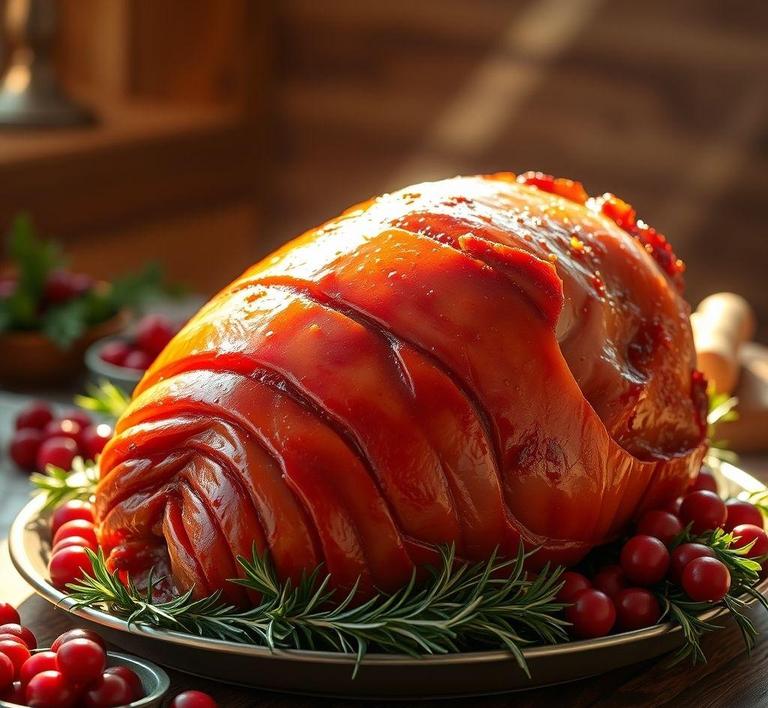Refreezing a whole ham might seem tricky, but with a bit of care and attention, it can be done safely without compromising flavor or texture. Whether you’ve cooked a large ham and have leftovers, or you’ve thawed one and just don’t have time to cook it all, understanding the proper way to refreeze can save you from waste. The key is to ensure the ham is handled correctly at every stage-from thawing to storage-so it stays delicious the next time you’re ready to enjoy it. In this guide, we’ll walk you through the best practices for refreezing a whole ham, so you can confidently keep your leftovers fresh for future meals.
Can You Refreeze Whole Ham?

Refreezing whole ham is a topic that often raises a lot of questions due to the potential risks and quality concerns that can arise. While it’s technically possible to refreeze ham, it’s important to understand the nuances surrounding it, especially regarding the type of ham, how it was originally stored, and the timing involved.
Ham, like most meat products, can be safely refrozen if handled properly. The USDA guidelines state that meat can be refrozen if it was thawed in the refrigerator and hasn’t been left at room temperature for more than two hours. However, there are specific conditions and precautions to keep in mind to ensure that the process is safe and the ham remains safe to eat.
How To Refreeze Whole Ham?
Refreezing a whole ham requires careful handling to preserve its safety and quality. Here are the steps to follow to refreeze ham effectively:
-
Check How It Was Thawed:
Before refreezing, it’s essential to ensure the ham was thawed in the refrigerator. If it was defrosted using other methods, like on the countertop or in warm water, it should not be refrozen, as these methods can promote bacterial growth.
-
Prepare the Ham:
If the ham is cooked, ensure that it’s properly cooled before refreezing. Ham should be refrigerated within two hours of cooking to prevent the growth of harmful bacteria. When preparing a whole ham for refreezing, consider whether you want to refreeze it as-is or slice it into smaller portions. Slicing the ham can make it easier to thaw later, especially if you don’t need a large portion at once.
-
Wrap It Well:
To maintain the best possible quality, wrap the ham tightly in plastic wrap, aluminum foil, or freezer paper. If the ham is not wrapped properly, air exposure can cause freezer burn, which impacts the texture and flavor of the meat. For added protection, place the wrapped ham into a heavy-duty freezer bag or an airtight container to minimize moisture loss.
-
Label and Date:
Always label the package with the date it was refrozen. This will help you keep track of how long the ham has been in the freezer. While frozen ham can remain safe to eat indefinitely if stored at a consistent temperature of 0°F (-18°C), its quality may deteriorate over time.
-
Freezing:
Once properly wrapped and labeled, place the ham in the coldest part of your freezer. The faster it freezes, the better the texture will be when thawed. If you’re freezing a whole ham, make sure there’s enough space in the freezer for air to circulate around it, which helps with even freezing.
Quality Impact
While refreezing whole ham is safe when done properly, it can impact the quality of the meat. Here are the main factors to consider:
-
Texture:
One of the most significant concerns when refreezing ham is the potential change in texture. When ham is frozen and thawed, ice crystals form inside the meat. These ice crystals can break down the muscle fibers, which may result in a less tender texture when the ham is thawed. The same is true when refreezing: ice crystals will form again, and the texture may become more grainy or dry. While this may not be noticeable with smaller slices or when used in soups and stews, it could be more evident when serving large slices of ham.
-
Flavor:
Refreezing ham could also affect its flavor. The freezing process can lead to moisture loss, which in turn can dull the meat’s natural flavors. The ham may not have the same juiciness or richness after refreezing, especially if it was previously frozen, thawed, and cooked. Additionally, if ham was flavored or glazed before freezing, the second freeze may cause the flavors to weaken or become uneven.
-
Freezer Burn:
If the ham is not wrapped properly, it can develop freezer burn. Freezer burn occurs when air is exposed to the surface of the food, causing dehydration and the formation of off-tasting, dry patches. While freezer-burned ham is safe to eat, the affected parts will be dry and tough, and the flavor can be compromised. To prevent freezer burn, ensure that the ham is securely wrapped and stored in an airtight environment.
-
Nutritional Quality:
Freezing and refreezing meat does not significantly affect its nutritional value, so the ham will retain its protein, vitamins, and minerals. However, excessive moisture loss due to improper storage could result in a slight loss of some nutrients, particularly those that are sensitive to temperature fluctuations, like vitamin C (though ham is not a significant source of this nutrient).
Refreezing whole ham is certainly possible, but it comes with several considerations that you need to account for to ensure food safety and preserve quality. If you’ve thawed your ham properly in the refrigerator and plan to refreeze it within a short time frame, you can safely do so, though the texture and flavor might be compromised slightly after the second freeze. Proper wrapping, storage, and labeling are key to maintaining the best possible quality.
To maintain the best eating experience, it’s recommended to only refreeze ham once. If you have leftover ham, consider using it in dishes where texture changes are less noticeable, like casseroles, soups, or stews. Ultimately, while refreezing may slightly affect the quality of the ham, it remains a safe and practical option as long as proper guidelines are followed.
Is It Safe To Refreeze Whole Ham?
Refreezing whole ham can be a bit of a gray area for many home cooks and food safety enthusiasts. While it may be tempting to stick a leftover ham in the freezer for later use, the process is not without its potential risks, especially if not done correctly.
In general, it is safe to refreeze ham as long as it has been handled properly throughout its journey from freezer to fridge and back to freezer. The key here is to understand the potential dangers of bacteria growth during thawing, the quality degradation that can occur with multiple freeze-thaw cycles, and the proper storage methods that can minimize risks.
Ham, whether it’s cooked or uncooked, can safely be frozen and refrozen once if it’s handled properly. The ham must be thawed in the fridge and not at room temperature, as bacteria can multiply rapidly when the meat is exposed to warmer conditions. If the ham has been sitting at room temperature for more than two hours (or one hour in warmer weather), then it should not be refrozen under any circumstances due to the high risk of foodborne illness.
Moreover, quality concerns come into play when freezing and refreezing ham. Freezing causes ice crystals to form within the meat, and these can rupture the cells of the meat. When refrozen, the ham’s texture and moisture content can deteriorate, resulting in a less desirable taste and chewiness. Though not harmful from a food safety perspective, the experience of eating refrozen ham may be less than ideal.
Signs That Whole Ham Should Not Be Refrozen
Even though refreezing whole ham is generally safe if done correctly, there are some crucial signs that indicate the ham should not be refrozen. These include:
-
If It Has Been Left Out for Too Long
If your whole ham has been thawed at room temperature for more than two hours, it is unsafe to refreeze. The USDA recommends that perishable foods, including meat, should not be left out for more than two hours at room temperature to prevent bacterial growth. If your ham has exceeded this time, discard it, as refreezing it could lead to foodborne illness.
-
If the Ham Has Already Been Refrozen
Refreezing ham that has already been through one thawing and freezing cycle can cause severe quality degradation. Each time the meat is frozen and thawed, more moisture is lost, leading to a dry, tough texture. Multiple cycles of thawing and freezing also raise the chances for bacterial contamination. If you’ve already refrozen your ham once, don’t make the mistake of doing it again.
-
If It Shows Signs of Spoilage
If the ham has an off smell, discoloration, or a slimy texture, then it’s a clear indication of spoilage, and it should not be refrozen. Even if the ham looks perfectly fine, any abnormal odor or texture could be a sign that bacteria have started to grow, and it’s best to dispose of the meat rather than risk food poisoning.
-
If the Ham Was Thawed Improperly
If the ham was thawed using unsafe methods-such as being left on the counter to thaw at room temperature-it is not safe to refreeze. The proper way to thaw a whole ham is to place it in the refrigerator, where it can defrost slowly and remain at a safe temperature. If it was thawed in hot water or at room temperature, there’s a chance it has been exposed to a temperature range that promotes bacteria growth.
Common Refreezing Mistakes
While refreezing whole ham might seem straightforward, there are several common mistakes people often make that can affect both the safety and quality of the ham:
-
Thawing Improperly
One of the most significant mistakes people make is thawing ham in unsafe ways. Some may choose to thaw it on the kitchen counter, which exposes it to the danger zone for bacterial growth (between 40°F and 140°F). Thawing ham in the refrigerator is always the safest method, as it keeps the meat at a consistent, cold temperature. If you’re in a hurry, you can also thaw the ham using the microwave or in cold water, but those methods require immediate cooking afterward.
-
Overcrowding the Freezer
Another mistake is overcrowding the freezer, which can prevent the ham from freezing properly. If the freezer is too full, cold air cannot circulate efficiently, and this might result in uneven freezing. It’s crucial to leave enough space in the freezer for air to circulate around the meat, ensuring it freezes evenly and quickly. If the ham freezes slowly, ice crystals will form in larger clumps, leading to a poorer texture once thawed.
-
Not Wrapping the Ham Properly
Poor packaging is a surefire way to ruin the quality of your ham. Refreezing ham without properly wrapping it will expose it to freezer burn. Freezer burn occurs when the meat is exposed to air, causing dehydration and discoloration. To avoid this, wrap your ham tightly in plastic wrap or foil, and then place it inside a freezer-safe, airtight bag or container to prevent air exposure.
-
Not Labeling the Ham
Many people forget to label the ham with the date it was frozen or refrozen, which can lead to confusion later. Refrozen ham should ideally be consumed within 2-3 months for the best quality. If you don’t label it, you risk keeping it in the freezer for too long and compromising both flavor and texture. Always use a permanent marker to write the date on your freezer bags or containers.
Tips And Tricks For Refreezing Whole Ham
-
Divide into Smaller Portions
If you know you won’t use the entire ham at once, it’s better to divide it into smaller portions before refreezing. This way, you can thaw only what you need later, which reduces the chances of having to refreeze the ham again. Slice the ham into manageable portions and wrap each portion separately. This method helps preserve quality and ensures you won’t waste any leftovers.
-
Freeze Within 2 Hours of Thawing
To ensure the safety of your ham, refreeze it as soon as possible after thawing, ideally within 2 hours. The longer it sits out at room temperature, the higher the risk of bacterial growth, so make sure you act quickly to get it back into the freezer.
-
Use a Vacuum Sealer
For the best possible preservation of your ham, consider using a vacuum sealer. Vacuum-sealed bags remove air, which is a major contributor to freezer burn. By sealing the ham tightly, you not only prevent air exposure but also help the ham maintain its moisture, texture, and flavor over time.
-
Keep a Temperature Log
Keep track of the temperature in your freezer, especially if it’s an older model or if you’re concerned about temperature fluctuations. The ideal temperature for storing frozen foods is 0°F (-18°C). A thermometer placed inside the freezer can help ensure that your food is consistently stored at the proper temperature, preventing issues like thawing and refreezing.
Conclusion
While refreezing whole ham can be done safely under the right conditions, it requires careful attention to both food safety and the quality of the meat. As long as the ham has been properly thawed and has not been left out too long, you can freeze and refreeze it once. However, the quality will likely degrade with each freeze-thaw cycle, so it’s best to limit how often you refreeze the same ham.
By recognizing the signs that your ham is no longer safe to refreeze-such as spoilage, improper thawing, or extended periods at room temperature-you can avoid health risks. Similarly, avoiding common mistakes like overcrowding the freezer or not properly wrapping the ham will ensure that your refrozen ham remains as safe and tasty as possible.
So, if you’re ever unsure about whether to refreeze your ham, just remember that safety first! And when in doubt, using best practices for freezing, thawing, and refreezing will help you avoid unnecessary waste while maintaining the best quality in your leftover ham.


